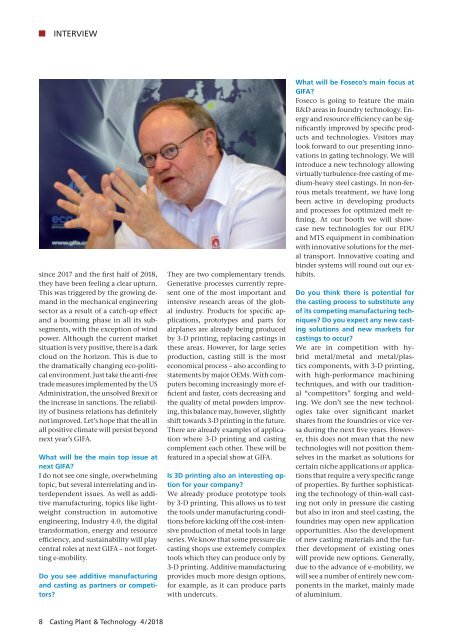CPT International 04/2018
Create successful ePaper yourself
Turn your PDF publications into a flip-book with our unique Google optimized e-Paper software.
INTERVIEW<br />
since 2017 and the first half of <strong>2018</strong>,<br />
they have been feeling a clear upturn.<br />
This was triggered by the growing demand<br />
in the mechanical engineering<br />
sector as a result of a catch-up effect<br />
and a booming phase in all its subsegments,<br />
with the exception of wind<br />
power. Although the current market<br />
situation is very positive, there is a dark<br />
cloud on the horizon. This is due to<br />
the dramatically changing eco-political<br />
environment. Just take the anti-free<br />
trade measures implemented by the US<br />
Administration, the unsolved Brexit or<br />
the increase in sanctions. The reliability<br />
of business relations has definitely<br />
not improved. Let’s hope that the all in<br />
all positive climate will persist beyond<br />
next year’s GIFA.<br />
What will be the main top issue at<br />
next GIFA?<br />
I do not see one single, overwhelming<br />
topic, but several interrelating and interdependent<br />
issues. As well as additive<br />
manufacturing, topics like lightweight<br />
construction in automotive<br />
engineering, Industry 4.0, the digital<br />
transformation, energy and resource<br />
efficiency, and sustainability will play<br />
central roles at next GIFA – not forgetting<br />
e-mobility.<br />
Do you see additive manufacturing<br />
and casting as partners or competitors?<br />
They are two complementary trends.<br />
Generative processes currently represent<br />
one of the most important and<br />
intensive research areas of the global<br />
industry. Products for specific applications,<br />
prototypes and parts for<br />
airplanes are already being produced<br />
by 3-D printing, replacing castings in<br />
these areas. However, for large series<br />
production, casting still is the most<br />
economical process – also according to<br />
statements by major OEMs. With computers<br />
becoming increasingly more efficient<br />
and faster, costs decreasing and<br />
the quality of metal powders improving,<br />
this balance may, however, slightly<br />
shift towards 3-D printing in the future.<br />
There are already examples of application<br />
where 3-D printing and casting<br />
complement each other. These will be<br />
featured in a special show at GIFA.<br />
Is 3D printing also an interesting option<br />
for your company?<br />
We already produce prototype tools<br />
by 3-D printing. This allows us to test<br />
the tools under manufacturing conditions<br />
before kicking off the cost-intensive<br />
production of metal tools in large<br />
series. We know that some pressure die<br />
casting shops use extremely complex<br />
tools which they can produce only by<br />
3-D printing. Additive manufacturing<br />
provides much more design options,<br />
for example, as it can produce parts<br />
with undercuts.<br />
What will be Foseco’s main focus at<br />
GIFA?<br />
Foseco is going to feature the main<br />
R&D areas in foundry technology. Energy<br />
and resource efficiency can be significantly<br />
improved by specific products<br />
and technologies. Visitors may<br />
look forward to our presenting innovations<br />
in gating technology. We will<br />
introduce a new technology allowing<br />
virtually turbulence-free casting of medium-heavy<br />
steel castings. In non-ferrous<br />
metals treatment, we have long<br />
been active in developing products<br />
and processes for optimized melt refining.<br />
At our booth we will showcase<br />
new technologies for our FDU<br />
and MTS equipment in combination<br />
with innovative solutions for the metal<br />
transport. Innovative coating and<br />
binder systems will round out our exhibits.<br />
Do you think there is potential for<br />
the casting process to substitute any<br />
of its competing manufacturing techniques?<br />
Do you expect any new casting<br />
solutions and new markets for<br />
castings to occur?<br />
We are in competition with hybrid<br />
metal/metal and metal/plastics<br />
components, with 3-D printing,<br />
with high-performance machining<br />
techniques, and with our traditional<br />
“competitors” forging and welding.<br />
We don’t see the new technologies<br />
take over significant market<br />
shares from the foundries or vice versa<br />
during the next five years. However,<br />
this does not mean that the new<br />
technologies will not position themselves<br />
in the market as solutions for<br />
certain niche applications or applications<br />
that require a very specific range<br />
of properties. By further sophisticating<br />
the technology of thin-wall casting<br />
not only in pressure die casting<br />
but also in iron and steel casting, the<br />
foundries may open new application<br />
opportunities. Also the development<br />
of new casting materials and the further<br />
development of existing ones<br />
will provide new options. Generally,<br />
due to the advance of e-mobility, we<br />
will see a number of entirely new components<br />
in the market, mainly made<br />
of aluminium.<br />
8 Casting Plant & Technology 4 / <strong>2018</strong>

















